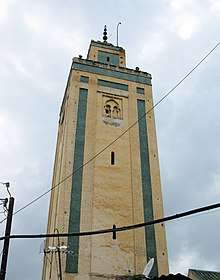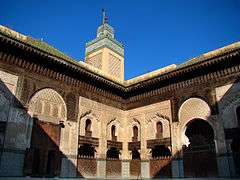Moulay Abdallah Mosque
The Moulay Abdallah Mosque or Mosque of Moulay Abdallah is a major mosque and royal necropolis complex situated in the center of the Moulay Abdallah district in Fes el-Jdid, the historic palace-city and citadel in Fes, Morocco. It was founded by the Alaouite sultan Moulay Abdallah (ruled intermittently between 1729 and 1757) who is buried in the adjoining necropolis along with later members of the dynasty.[1][2][3]

Historical background
The mosque is located Fes el-Jdid ("New Fes"), which was originally a royal citadel and administrative city founded in 1276 by the Marinid dynasty.[1] Fes el-Jdid originally housed many of the sultan's troops and it also continued to house the royal palace up to modern times. In the 17th century the Alaouite sultan Moulay Rashid built the large Kasbah Cherarda north of Fes el-Jdid in order to house his tribal troops,[1] which in turn liberated new space in the city. This included the northwestern area of Fes el-Jdid which then became the Moulay Abdallah neighbourhood from the early 18th century onward.[4]:296 This is where Sultan Moulay Abdallah (ruled 1729–1757) erected the mosque and a royal necropolis where he himself was buried after his death. The necropolis continued to serve as a necropolis for the Alaouite family afterwards, and was reworked into its current form by Muhammad ibn Abd ar-Rahman in the mid-19th century (before his accession to the throne in 1859, while he was still serving as deputy under his father). It later came to house the tombs of Sultan Moulay Youssef, who was buried here in 1927, and of Moulay Abdelaziz and Moulay Abd al-Hafid, who were buried here in 1943 and 1937 respectively.[3][5]
The mosque also once had madrasa which offered initial training (in Qur'anic studies) to less-educated students before they went on to study at the al-Qarawiyyin University.[1]:463 An old historic hammam is (or was) also located just west of the mosque.[3]
See also
References
- Le Tourneau, Roger (1949). Fès avant le protectorat: étude économique et sociale d'une ville de l'occident musulman. Casablanca: Société Marocaine de Librairie et d'Édition. pp. 88, 98, 463.
- Marçais, Georges (1954). L'architecture musulmane d'Occident. Paris: Arts et métiers graphiques. p. 391.
- Maslow, Boris (1937). Les mosquées de Fès et du nord du Maroc. Paris: Éditions d'art et d'histoire. pp. 86–91.
- Métalsi, Mohamed (2003). Fès: La ville essentielle. Paris: ACR Édition Internationale. ISBN 978-2867701528.
- Bressolette, Henri (2016). A la découverte de Fès. L'Harmattan. ISBN 978-2343090221.

